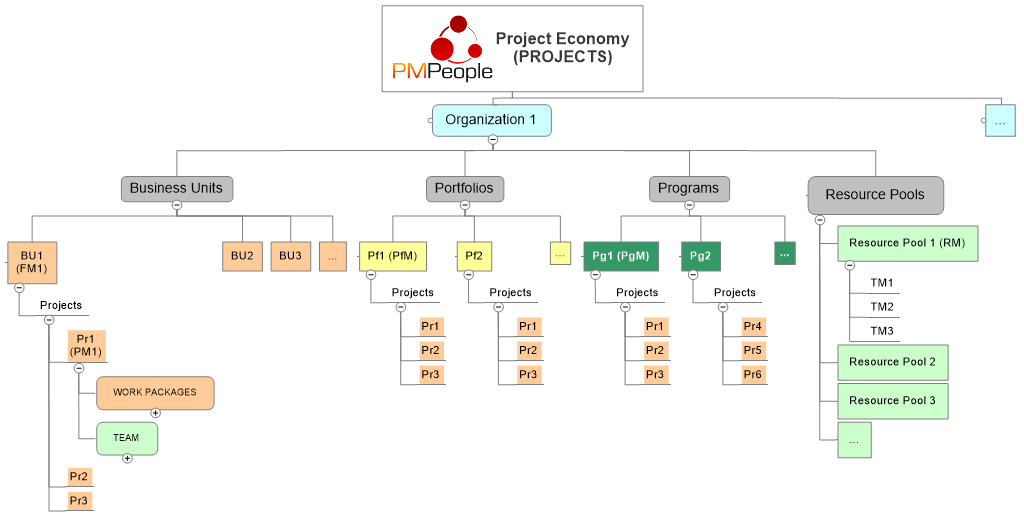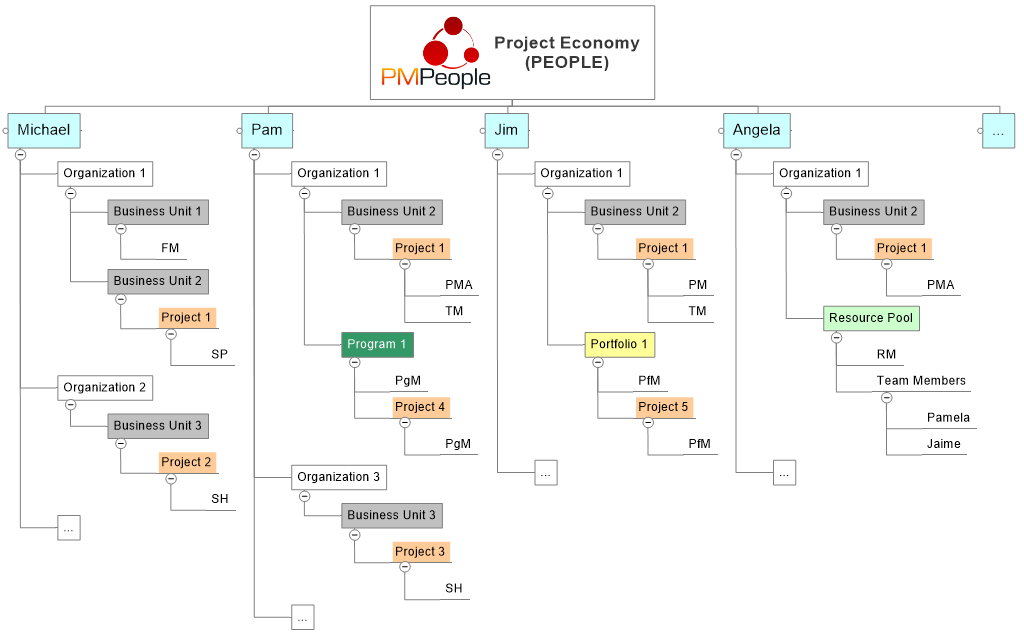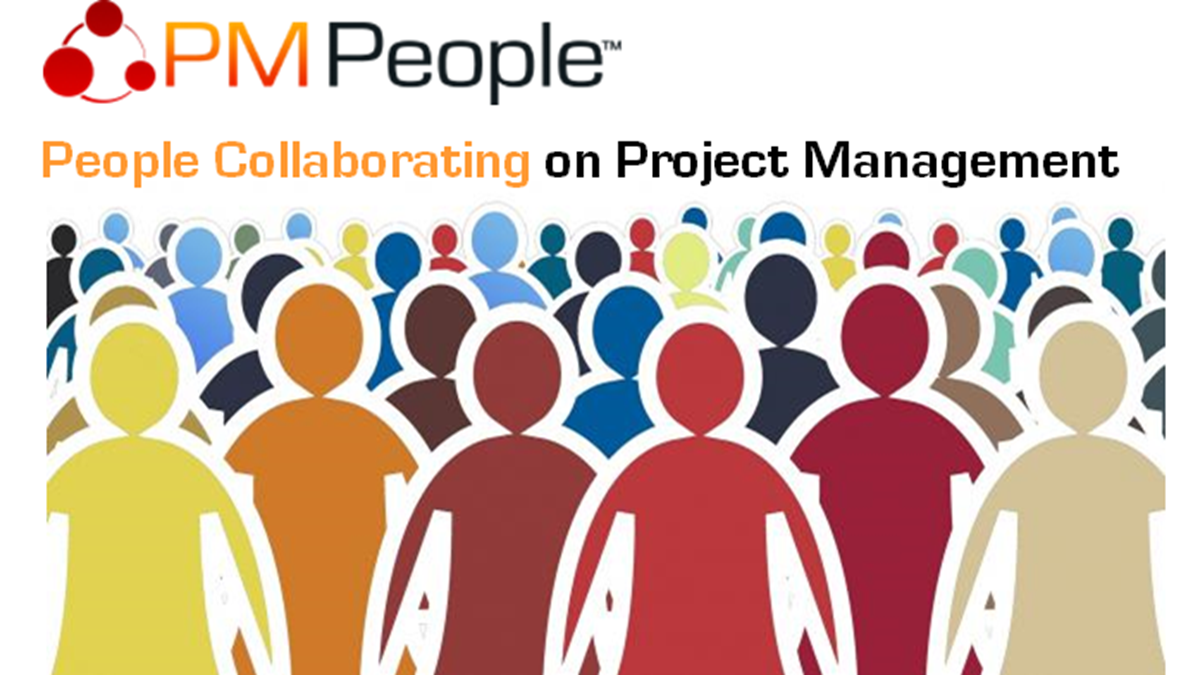In the Project Economy, people have the skills and capabilities they need to turn ideas into reality. If we take a high-level picture of the project economy, we can see it as a set of organizations, each of them carrying out many projects at the same time, managing each of them carefully because they know that project management make a difference, more than operations management.
Let’s enter into one of these organizations. From above, we see projects organized in various groups called Business Units managed by Functional Managers. Inside business units, functional managers have a number of projects included for some business reasons.

How is each project organized? There is a person in charge of each project, called the Project Manager. Project managers carry out professional project management and get things done. The professional way to manage a project starts by breaking it down into manageable chunks called work packages. A work package contains a series of tasks, deliverables, requirements, milestones, etc. Any professional project manager usually manages the project at the work package level. He or she can tell how the package is doing on schedule, costs, risks… If there are some issues, they have to identify them at the work package level to make focused decisions.
The project is done with people working as a team, they are the project Team Members. They can be assigned to project work packages and can do many tasks within those packages. When a team member needs to review what he is supposed to do, at the project level, he usually has an assignment description for that particular work package. If he needs to submit timesheets or expenses, he can do it at the work package level.
Apart from this high-level assignment description, project team members should do many detailed things. There is no point in modeling all details from the governance perspective. Micromanagement is bad practice and should be avoided in professional project management. Besides, high performance teams usually are self-organized teams.
Managing bottom up, from work packages up to the project itself, everybody can tell how the project is doing on schedule, cost, etc.
In the project economy, team members are usually grouped into specialized units called resource pools, managed by Resource Managers. They manage the people who are members of “the pool”, give proper attention to their assignments, help them on their career path, etc. They will also anticipate if more people are needed (they manage resource capacity), what people are assigned to which projects, etc. They have an operational role, similar to what HR people do, but the advantage of resource pools is that organizations can have highly specialized project team members.
Projects can be grouped into business units, but they can also be grouped in other ways. Some projects need to be managed as portfolios, or programs.

The main difference between portfolios and programs is that portfolios have a strategic mission. For instance, a strategic organizational multiyear change plan is normally outlined as a series of projects (20-50 projects). Those projects have to be managed as project portfolios for operational reasons. Portfolios also have managers, called Portfolio Managers. Portfolio manager #1 is managing portfolio #1, including some projects coming from different business units. Any project belongs to one business unit, and optionally it is included in one or many portfolios, and in one program. Notice that projects may belong to many portfolios, but only to one program or no one.
The main difference between portfolio and program is that programs tend to be more cohesive groupings. A large project is usually managed as a program when is divided into subprojects. Subprojects within a program have to be managed in a very cohesive way “as a block”, and there is a person in charge of making sure that the aggregated benefit is delivered within the scope of that program. We call him the Program Manager.
There are different professional forms to manage projects: the Project Manager knows how to finish the project the product result to on time, on cost, with the right quality, within scope and delivering value to stakeholders. The Portfolio Manager knows how to make that set of projects within its portfolio comply with the strategic needs and new projects are aligned and appropriately prioritized (what projects are done before and what projects after). The Program Manager wants to deliver the added benefit of managing those projects in block. There are standards for each of these ways of managing.
In the project economy projects are organized in organizational structures. Projects fit into business units and can be part of one or more portfolios and one program. This is the organizational view of projects. In summary: projects are not organized as a “comb shaped chart” just one level below the management team. On the contrary, projects are quite structured in organizations, and this makes specialization possible.
In the Project Economy, projects are organized in organizational structures to enhance specialization.
Let’s see the perspective of people in the Project Economy: how people can collaborate to effectivelly manage several projects, in several organizations, within different business units, in different portfolios, programs, teams, etc. Let’s illustrate using some examples.

Let’s take the case of Michael, who has participation in two organizations: one is the company you work for; the other is a volunteering organization. In the first organization, Michael is the Functional Manager of Business of Unit #1. He has to follow the projects in BU #1 from a financial point of view: he needs to check what projects are anticipating losses, delays, etc. Regarding the project #1 in Business Unit #2, his role changes to Project Sponsor, since he was the one who approved and authorized that project inside the organization. When he enters organization #2 he can follow project #2 at business unit #3, as an Project Stakeholder. We can see that in the project economy, people need to collaborate in project management in different ways, according to their knowledge or interest.
Now let’s see Pam’s point of view. She has projects in two organizations: in the same organization than Michael (organization #1) and in a different organization (organization #3). Pam enters organization #1, in the business unit #2, in the same project that Michael is sponsoring, to work as a PM Assistant. Pam can help the PM to manage this project, so that the PM is not a bottleneck. In addition, she has some work assignments to project #1: She can submit hours and expenses using the role of team member. People can collaborate from different roles in the Project Economy.
In another example we see that Pam enters as a Program Manager of program #1. She can follow the projects inside that program from the perspective of the program manager, to manage, for instance, the value that project #4 is delivering, how this project is affected by other projects’ dates, risks, etc. She will manage the aggregated timeline as a whole. Program management is different than project management since they are driven to benefit realization. Their mindset is that “the whole is greater than the sum of its parts”. In organization #3, Pam can enter another project as a stakeholder.
Jim can enter organization #1, business unit #2, in that same project #1, but now as the Project Manager. Jim has Pam as his assistant, but he is accountable for that the project to finish on time, on budget, and to deliver the final product, service or result, and value to stakeholders. When Jim uses the team member role, he can submit hours and expenses, since he has work assignments, too. It is quite common that project managers have also technical work to do in projects.
Within the same organization #1, Jim has the role of Portfolio Manager. He is the portfolio manager of portfolio n#1 which, among others, includes project #5. Portfolio Managers manage with strategy in mind. Jim is concerned about how each project keeps aligned, meets the strategic goals, how it contributes to business drivers, etc.
Let’s finally see Angela. Angela also collaborates in organization n#1, in business unit #2, where she also helps Jim as a supportive PMO, along with Pam. Additionally, Angela uses the role of Resource Manager of a resource pool including project team members like Pam and Jim. From her Resource Manager role she manages their training needs and their professional careers. She can also control in which project they work as team members.
In the Project Economy, people collaborate in project management according to their knowledge or interest.
PMPeople is the tool for the project economy. It is aimed to unify professional project management by these differential points:
- Designed by and for professional project managers, following professional project management standards.
- Online productivity –less meetings, less documents, less workflows– through distributed collaboration among 12 specialized roles: Organization Owner, 6 roles on demand management and 5 roles on supply management.
- Freemium product –unlimited time, unlimited users– usable via web and mobile application.
Start using PMPeople for free, for unlimited time and for any number of users. In premium organizations, only managers have a cost. Several roles –stakeholders, team members, sponsors and resource managers– are always free. You can increase or decrease your premium seats according to the organization actual needs. Premium organizations have access to our interactive support through Slack. Our servers are located in EU. This software can also be hosted on customer premises.
Jose Barato
Related posts
Categories
- Business (16)
- Demand Management Roles (14)
- Frequently Asked Questions (7)
- Guide (26)
- People (23)
- Assignments (2)
- Feedback (2)
- Project Team (3)
- Tracking Time And Expenses (2)
- Process (9)
- Closing (2)
- Executing And Controlling (2)
- Planning (1)
- Project Management (67)
- Management Frameworks (18)
- Organization Owner (OO) (3)
- Project Economy (54)
- Tools (19)
- Supply Management Roles (5)
- Training (6)
- Uncategorized (1)





